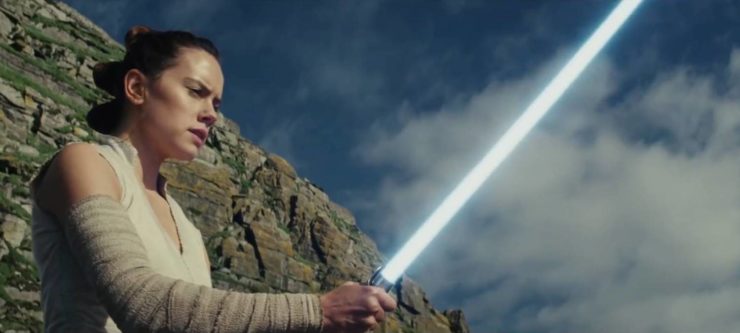With all respect to Rodgers and Hammerstein, sometimes the ending can also be a very good place to start. So let’s start there, let’s start with the ending: Let’s start with a young stable boy being chastised by his master for regaling his friends with the exploits of Luke Skywalker, complete with hand-made action figures. He emerges from his quarters, uses the Force to grab his broom, and then takes a defiant stance beneath a canopy of stars.
Mind you, this scene comes after Star Wars Episode VIII: The Last Jedi has, for all intents and purposes, ended, after the tattered remnants of the resistance have once more escaped the clutches of the First Order and are licking their wounds, and counting what few heads remain. As a curtain call, it’s odd—not so much saying, “Thank you for enjoying our little show” (the kid’s facing away from us, after all), as, “It’s been four decades with the Skywalkers, folks. Can’t you take a hint?”
In a franchise that has become notorious as much for the conflicts that are waged outside of its fantasy realm as within, the struggles over The Last Jedi have been among the most curious. Greeted with enthusiasm by some (including yours truly), ambivalence by others, and vehement hostility by the usual regressive suspects, the film has fallen between the cracks of the love-‘em-or-hate-‘em responses that have greeted the series’ other episodes. So much so that, paradoxically, it has attained a kind of nonentity status, a let’s-pretend-this-didn’t-happen standing that has denied it an appreciation as (yes, I’m gonna say it) the franchise’s second-best film, right behind (brace yourselves) the original Star Wars. (What can I say? Welcome to Heresies “R” Us.)
But it’s Last Jedi’s status as odd duck in the overall series that makes it so vital. The film’s producers may have thought that writer-director Rian Johnson would follow in the proud tradition of other indie directors who were conscripted into tent-pole productions only to find themselves so overwhelmed by logistics that they were incapable of bringing any of that dangerous creative thinking to the project. But the mind that had transported noir drama into a contemporary high school in Brick and coaxed the exceedingly rare, emotionally invested performance out of Bruce Willis in Looper was apparently not in the mood to deliver just another blow-up-the-Death-Star exercise. And as much as Johnson hewed to a general, action film mise en scène to appease his overseers, it’s all the pieces moving within that structure that delighted some viewers and got under the skin of others.
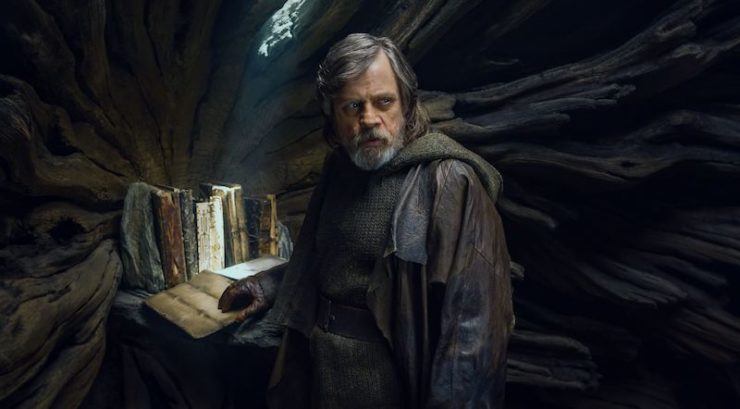
It doesn’t take long for the trope cart to be upended, starting with resistance pilot Poe Dameron’s (Oscar Isaac) sassing of First Order General Hux (Domhnall Gleeson) while the sneering villain tries to get through his supercilious, your-rebellion-is-doomed monologue (and, yes, closed captioning does confirm that Poe refers to him as “General Hugs,” a nickname which probably made a light-speed journey through the crew’s mess at the next lunch break). And the affronts kept coming from there: The plucky young X-wing pilot who snuffs it before she can even leave the hanger; the misdirection that steers Finn (John Boyega) and Rose Tico (Kelly Marie Tran) from the suave, oblivious Master Codebreaker (Justin Theroux) into the arms of the grungy, stuttering DJ (Benicio Del Toro); the fact that Our Heroes’ loose-cannon plan to engineer their fleet’s escape from the First Order’s non-stop barrage subverts the “so crazy it just might work” cliché, and winds up being merely foolhardy and pointless. And most traumatic for a large swath of the audience: The moment where The Last Jedi picks up from the emotional fade out of The Force Awakens, as a grizzled Luke Skywalker (Mark Hamill) takes the light saber proffered by Jedi-wannabe Rey (Daisy Ridley) …and casually tosses it off a cliff.
On the one hand, it was probably not the wisest strategy to take so indelible a closing image from the previous film—and a moment fans had been waiting a full two years to see play to its conclusion—and brush it off like so much Crait salt. Johnson may have been flexing some iconoclast muscles there, but it’s just as clear that his goal wasn’t to stick a thumb in the fans’ eyes. The director was going for something more profound and subtle, creating something meant to question what we sought from a forty-year-old franchise, explore why we were still seeking it, and critique the calcifying nature of franchises overall. (For the sake of perspective, Colin Trevorrow’s Jurassic World attempted the same subtextual gambit two years earlier, to far more muddled results.)
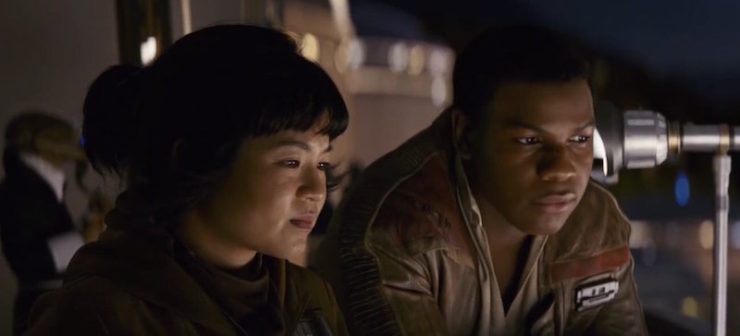
It was, perhaps, a fool’s mission. For all of Star Wars’ occasional feints toward profundity—how many franchises can say they inspired their own religion?—the series has always been first and foremost popcorn entertainment. Asking the audience if they weren’t tired of living the same Hero with a Thousand Faces scenario for the thousand-and-first time was always going to be met with some friction, even without the audience having been primed two years prior by The Force Awakens, an episode that fairly screamed, “See? It’s yer old buddy Star Wars back again, with nary a trade embargo nor tussles for high ground in sight!”
Buy the Book
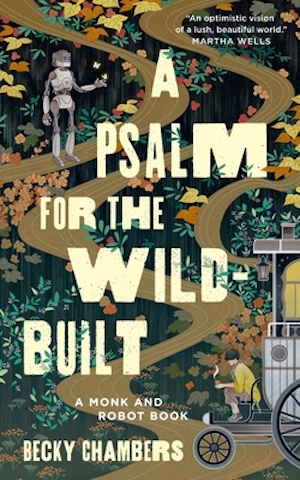

A Psalm for the Wild-Built
Whatever people anticipated from The Force Awakens’ follow-up—and to be fair, Episode VII’s writer-director J.J. Abrams (along with co-writers Lawrence Kasdan and Michael Arndt) imbued his characters with a humanity and wit that George Lucas could only dream of—fans expecting to sit back and let the action wash over them kept getting their defense mechanisms triggered. Instead of fetching, supremely confident, blaster-wielding princesses, there was Rose, a decidedly unglamorous mechanic whose fan-girl awkwardness in her initial exchange with reformed stormtrooper Finn may have resonated uncomfortably with some viewers (and whose abrupt turn from moony admiration to vengeful revulsion upon discovering Finn’s attempt at desertion may have stung some fans even deeper). Instead of the good guys always squeaking out an unlikely win by the skin of their teeth, we see failure after failure, and at significant cost. People die. Lots of people die.
And then there’s Rey, the hero to whom this Campbellian journey is supposed to belong. Except that her anticipated rise to heroism gets thwarted at every turn—Luke Skywalker taunts her superficial, it’s-all-about-lifting-rocks understanding of the Force and steadfastly refuses her call to fulfill his role as the last, noble icon of the Jedi Order. Instead of discovering herself to be part of a secret bloodline destined to fulfill a great prophecy, the Mystical, Magical Cave of All Wisdom only throws back her own face when Rey begs to see her parents, and Kylo Ren (Adam Driver) callously confirms that, in the vastness of the universe, she is nothing, descended from nothing.
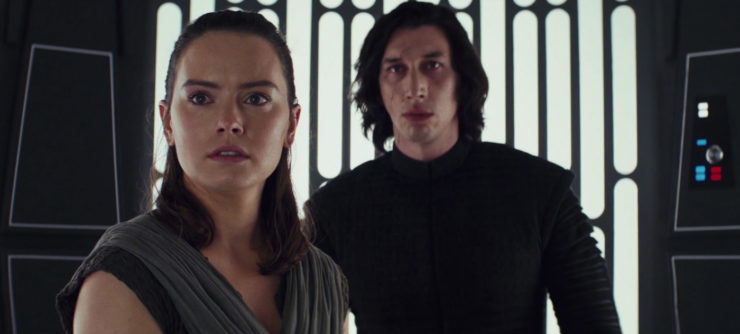
But let’s go back to that cave, for a sec—let’s go back to that moment when Rey tearfully beholds her own visage, and think about the question that poses. She looks to that mirror like we look to the screen, seeking meaningful answers in intangible images. But thrilling as it may be to imagine being born into a life of Great Destinies and Grand Victories, in the end we have to face that there is only us, humble and singular and—ideally—struggling to do our best. What the cave shows Rey is what we as an audience need to remember: There’s a dangerously fine line between inspiration and distraction. Returning repeatedly to someone else’s Great Journey of Discovery can pull us off the path of our own growth.
As impactful as Rey’s journey is—and indeed the film has its best moments in the tense, Force-linked exchanges between her and Kylo Ren—the most consequential sequence may be Rose’s monologue about the den of moral iniquity that is Canto Bight. Obi-Wan may have condemned Mos Eisley for the wretched hive of scum and villainy that it was, but at least its inhabitants’ malignancies were out front for all to see. Through Kelly Tran’s restrained yet blistering performance, Rose manages to uncover the rot hiding beneath the city’s pleasing exterior, then channels the pain of those who must suffer for others’ pleasure and exposes the agony of being powerless to help. The subsequent sequence where Rose unleashes a stampede of fathiers through the casino functions not just as a swell action sequence (even if the ease with which the beasts trash the place suggests the joint was nowhere near built to code) but reveals a soul rising to her own power, taking action in whatever ways that she can.
Which brings us back to that stable boy—the one whose assistance Rose recruited through the gift of her Super Secret Rebel Alliance Decoder Ring—and his stance before the whole infinity of the universe. He is inspired by the legend of Luke Skywalker, but does not look to the heavens for the mythical figure’s arrival. This seems to be the major lesson Rian Johnson wants to impart to his audience: Luke Skywalker is a fun diversion, but a fiction only. Our destinies may not all be epic, but even nothings from nowhere have the capacity to become their own brand of hero, if he/she so chooses.
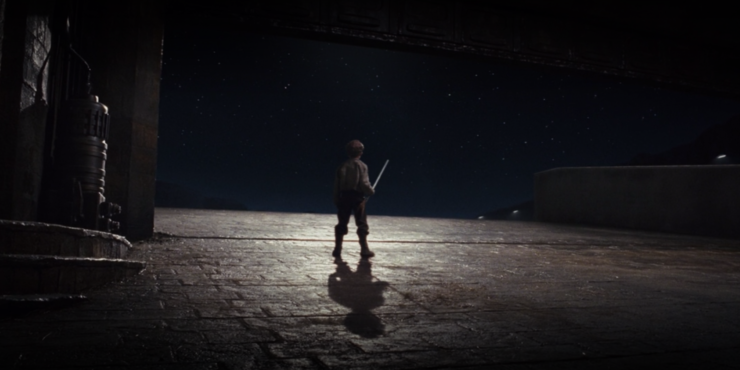
The Last Jedi ends with contradictions: The Sacred Tree burns, but it’s revealed that the Jedi texts are stowed safely aboard the Millennium Falcon (apparently never to be seen—or even referred to—again). Skywalker’s light saber is destroyed, but Rey is still poised to assume the mantle (with Luke’s Force ghost lurking nearby, you betcha). Maybe this was Johnson gently buffering his message, providing the more resistant (heh) members of the audience with an out if they wanted to take it. Whatever the motivation, it wasn’t enough for a phalanx panicked execs. Thus the next movie, The Rise of Skywalker: a hideous mélange of dropped plot threads (was a redemption arc in store for the duplicitous DJ?); hysterical retconning; the unjust exile of Rose (in case you hadn’t guessed, my pick for Last Jedi’s best new character); and Of course that lyin’ liar Kylo Ren was lyin’ about Rey; she’s got both a secret origin and a universe-shattering destiny; why, she’s even a SKYWALKER… kinda.
Could an alt-world Episode IX have picked up the gauntlet thrown by Johnson? Possibly. Colin Trevorrow—fresh off Jurassic World—was on-deck to shoot the next chapter. I haven’t read Duel of the Fates, the script that was purportedly drafted by the director and Derek Connelly, but the fact that Trevorrow had previously used John William’s beautiful, noble Jurassic Park theme to stage a flyover of a shopping mall at least suggests he was simpatico with Johnson’s objective. (And don’t worry about Rian, kids—he eventually found safe haven quirking up a cozy, locked-room murder mystery and managed to create a franchise of his very own). But for what it’s worth, Star Wars Episode VIII: The Last Jedi is about as radical a deconstruction of franchise films as could be possible while answering to the demands of a mammoth megacorp. It stands as the rare tent-pole movie designed not just to tickle your pleasure center, but wake you from your revery.
I can feel the storm clouds gathering now. Fair enough, I went into this with open eyes, and understand that there’ll be some… uhrm… passionate opinions about this. But that’s okay—your thoughts are heartily invited! No scorched earth, though—please keep your comments polite and friendly. Haven’t the Stars seen enough Wars, after all?
Dan Persons has been knocking about the genre media beat for, oh, a good handful of years, now. He’s presently house critic for the radio show Hour of the Wolf on WBAI 99.5FM in New York, and previously was editor of Cinefantastiqueand Animefantastique, as well as producer of news updates for The Monster Channel. He is also founder of Anime Philadelphia, a program to encourage theatrical screenings of Japanese animation. And you should taste his One Alarm Chili! Wow!










